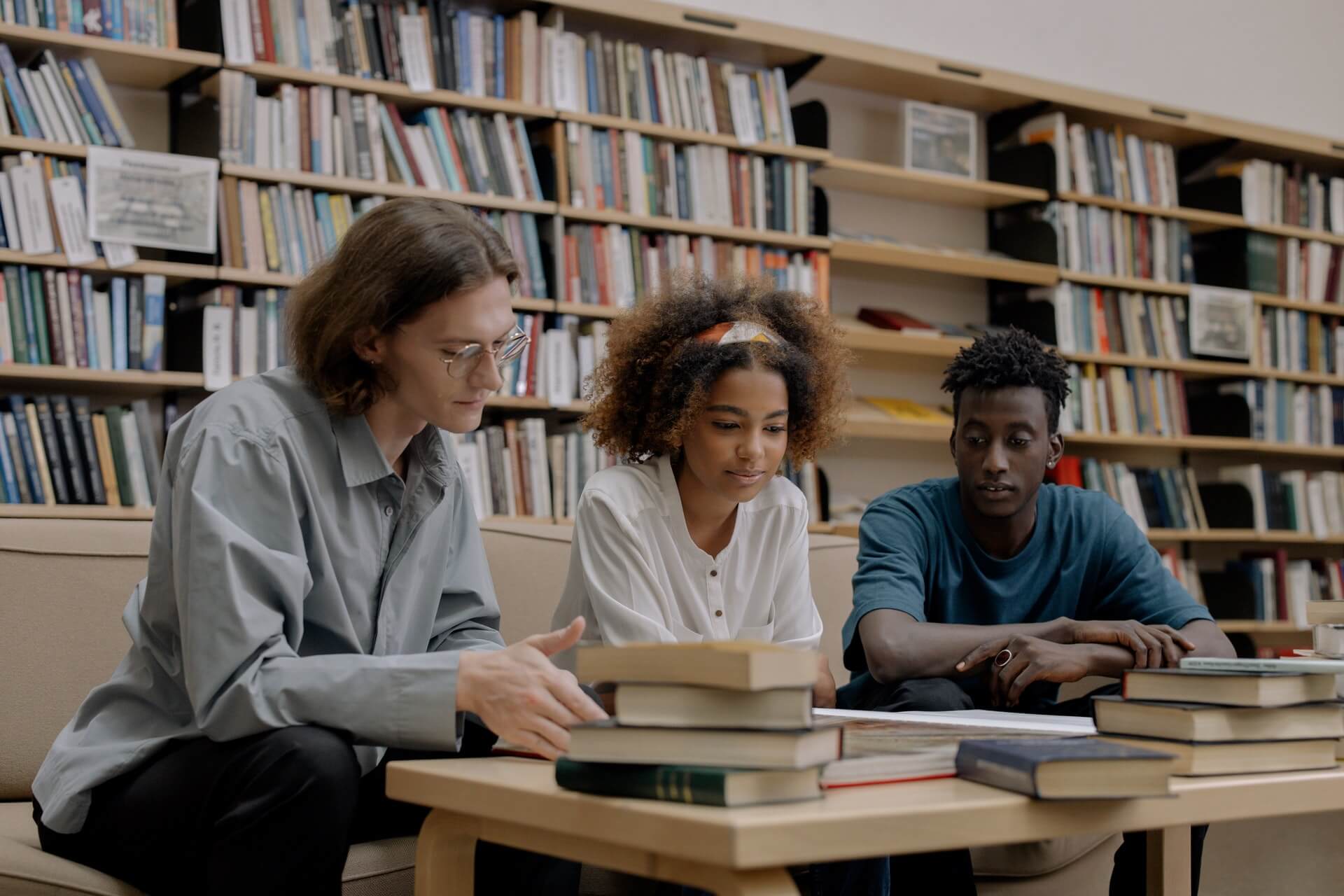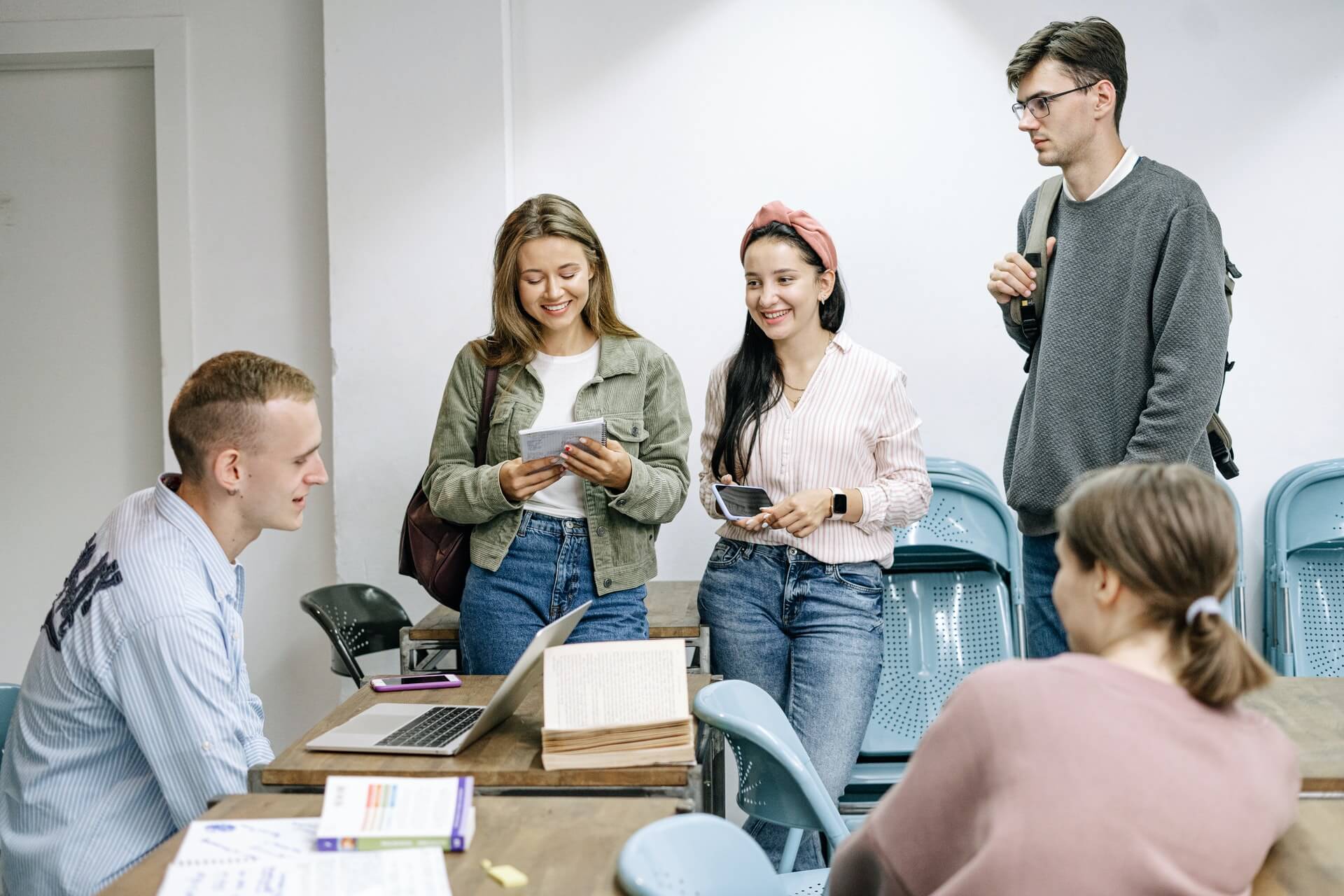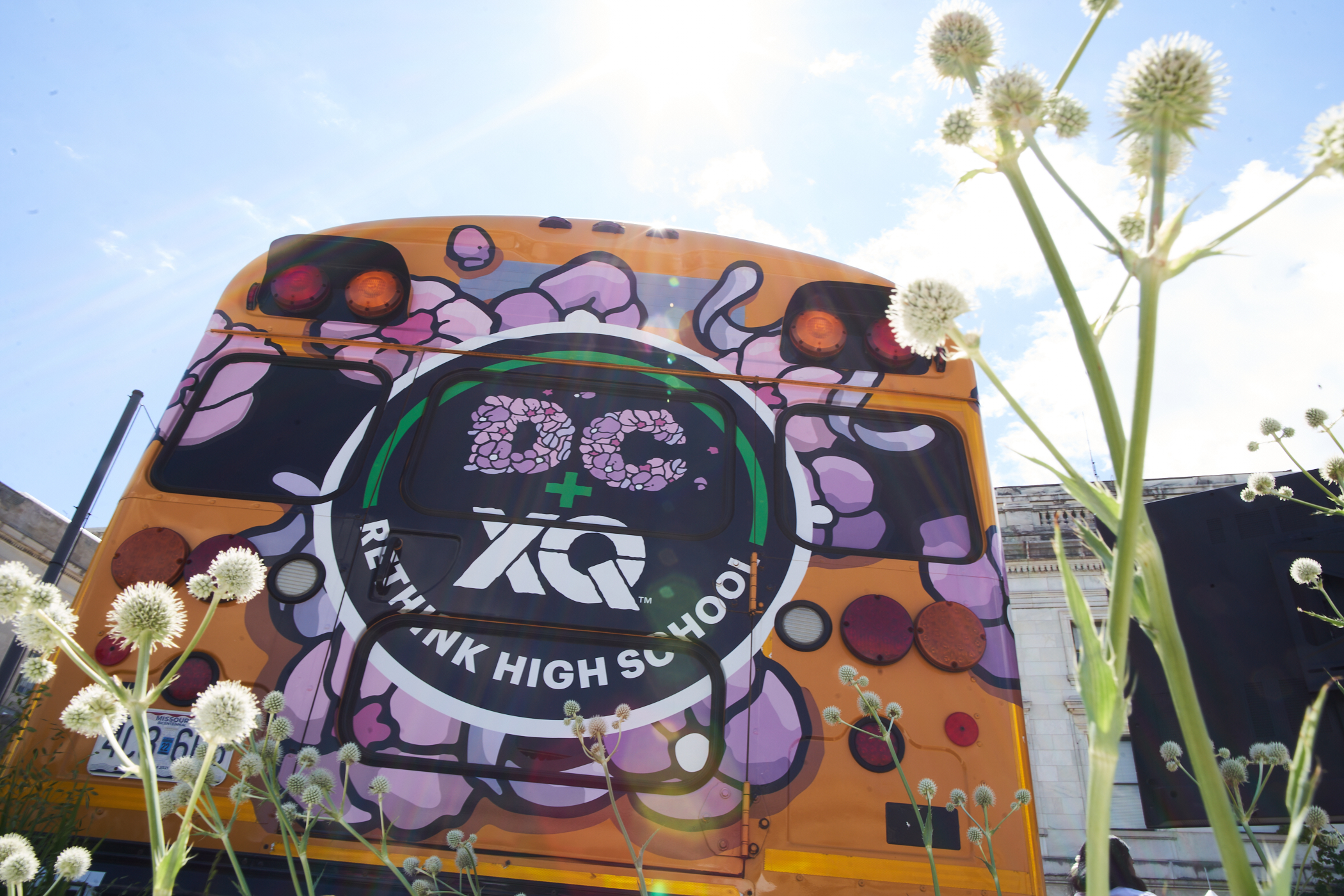What Is Student Centered Learning and Why Is It Important?
Too many students describe high school as boring—but it doesn’t have to be. Here's how we can put students at the center of their education.

When high school student Andres first arrived at Círculos, an XQ school in Santa Ana, CA, he wasn’t sure what to think. “I was skeptical when I first looked at it because it was so different from traditional high schools,” he said. “It was a classroom without walls.”
It’s true that Círculos does class differently: at school, students sit in circles instead of typical rows of desks, and have significant flexibility in their schedules. And like Andres noticed, a large portion of learning takes place through projects in the community, outside the traditional classroom. These structural features are all part of Círculos’s commitment to empowering and engaging students through student-centered learning.
Like the name implies, student-centered learning (SCL) makes students co-creators of their own education, engaging them in decisions about what, when, and how they learn. In doing so, SCL helps high schools prepare students not only with academic knowledge, but also with the skills of self-direction, curiosity, creativity, and collaboration they’ll need for future success. As Andres described the end of his time at Círculos: “They were always so open. ‘You want to do this? OK, let’s do it.’ They really taught me to be flexible and adaptable. That helped me grow beyond the classroom.”
Defining Student-Centered Learning
Students succeed when what they’re learning matters to them. In student-centered learning, students’ interest drives education. Student-centered learning gives students the opportunity to decide two things: what material they learn and how they learn it. (This concept is also sometimes referred to as personalized learning.) In contrast to teacher-centered approaches, SCL engages students as leaders and decision-makers in their own learning. For example, at Purdue Polytechnic High School in Indianapolis, IN, students engage in SCL in their Foundations class, as they solve real-world challenges posed by community partners—for example, how students would support a future world with 9.5 billion people living on it. Students plan their own research, propose a solution, communicate their ideas to teachers and community members, and evaluate their own progress as they go. Teachers help guide this process, but the content, timing, and motivation is down to students themselves.
[
Just for Teachers: XQ Xtra
Resources, stories and updates sent every two weeks about how we’re making high schools stronger.
SIGN UP
]
Because SCL is so personalized for each student and community, it can take many different forms. However, successful SCL programs share some common features:
What does student-centered learning actually feel like to students? Jada Johnson, a graduating senior from Brooklyn Laboratory High School, offered this reflection: “Teachers viewed scholars as more than students. … We were treated as individuals with our own ideas and viewpoints, and that were incorporated into classes and school governance. Brooklyn Lab gave me the strength to use my voice. Now, I’m not afraid to stand up and speak my opinion.”

How Educators Approach Student-Centered Learning
Classroom roles shift in SCL, as students take on leadership and teachers move away from being the sole deliverers of content. So how do educators experience this shift?
A 2018 study published in the International Journal of STEM Education asked this question, examining the experiences of a group of STEM educators transitioning to a student-centered approach. The study found that moving to SCL requires an identity-level shift in what it means to be a teacher. As one educator in the study put it, teachers move from being “content dispensers” to “content resources.”
Like any pedagogical approach, that shift in identity was more intuitive for some educators in the study than others. But almost all participating teachers—those who immediately embraced SCL and those who found it more challenging—ultimately reported benefits. They built better relationships with students, felt more attuned to classroom dynamics, and tailored learning to individual needs.
At XQ schools, which have a student-centered approach and emphasis on youth voice and choice, teachers describe the special pride that comes from seeing students succeed at goals they’ve set for themselves. In New Orleans, New Harmony High Director of Community and Partnership Anthony Burrell explained, “Regardless of what my students want to do, I just want to see them grow. And see how far they can go with it.”
What Is the Role of Curriculum in Student-Centered Learning?
School curriculum plays a central role in SCL. But instead of the traditional model, where students and teachers follow the same script, SCL schools use their curriculum as a resource to spark student interest and guide rigorous inquiry. Vera, a student at XQ school Crosstown High in Memphis, TN, explained, “Everything’s open for discussion: what we do and what we don’t do and how we approach it. It gives us the opportunity to pick our projects as long as it has this standard in it, and you master this competency within it.”
This relationship between curriculum and student interest stands out in a project completed by 9th graders at New Harmony High. To learn about the Great Migration, students completed student-driven, interdisciplinary projects, combining resources from their teacher, like readings from Langston Hughes and a trip to the Mississippi Delta, with their own historical research. Then, students came up with creative projects to synthesize their learning and relate to their community. Two students, Kira Tonikin and Sofia Olexia-Dangle, created artwork that won first and second place, respectively, in the New Orleans Public Library’s 2019 Black History Month poster contest for teenagers.
This project is just one example of how SCL teaches academic content alongside crucial life skills, like critical thinking, synthesis of multiple kinds of resources, and creativity. New Harmony teacher Burrell explained, “[Students] learn to engage with adults and speak in front of a diverse audience. This makes them more comfortable sharing their work, better speakers, and more confident. It challenges them in terms of critical thinking and analysis.”

Teacher Involvement in Student-Centered Learning
Teachers can put student-centered learning to use in their classrooms to increase students’ motivation, help students take ownership over their learning, and build strong relationships. Three ways to think about the role of teachers in SCL are: resources, mentors, and guides.
Resources
In student-centered learning, teachers serve as experts and key sources of knowledge, and students share responsibility for accessing that knowledge. This approach is embodied at Brooklyn Lab, where during the pandemic, students engaged with tutorial sessions held by InnovateEDU Fellows. In these sessions, students were responsible for taking the lead in communicating what they understood and what they didn’t, learning vital skills of self-advocacy while benefiting from teachers’ knowledge and expertise.
Teachers are also resources for connecting students with partnerships outside of the classroom. For example, at Iowa BIG, an XQ school in Cedar Rapids, IA, students work with peers from across the city to complete projects designed by businesses and community partners. This kind of connection is a powerful way to implement SCL by connecting students with out-of-school interests, engaging them in work settings, and fostering career connections.
Mentors
Relationships are crucial to learning, and that’s especially true in SCL. Strong relationships with trusted adults give students the confidence and motivation they need to take leadership in their learning. At Círculos, this emphasis on relationships is built into the school’s mission: to provide a “circle” of support for students. And it’s paid off—as student Alexies explained, “The difference, at this school, is community. When I first came to this country, I felt very alone. But this school was like a family. They really accepted me for who I am. Everyone was so nice and accepting, it gave me a real sense of belonging.”
Guides
Teachers provide the structure and guidance that enables students to overcome challenges and see how their classwork connects to larger interests and goals. For example, at XQ school PSI High in Sanford, Florida, teachers create visual content maps that students and parents can access to see the big picture of the student learning journey in any particular unit. Understanding how their day-to-day work translates to future goals activates students’ intrinsic motivation, allowing them to take the lead.
Student Pedagogy
The pedagogy used in SCL environments is designed with students at the core—it activates prior student knowledge, connects to students’ experiences, and adapts to their needs. To create this kind of pedagogy, schools need to understand the experiences of students and their backgrounds.
During the pandemic, Brooklyn Lab built a powerful tool to do just that: their “Student Personas for Empathy-Building,” is an interactive website featuring five student personas and the counselors, teachers, and other adults who support them. This tool helps educators, families, and school community members understand the most vulnerable students and make a plan for their success, and is a fantastic resource for any school looking to develop SCL pedagogy.
Once teachers and administrators take the time to understand individual student needs, they can guide students toward meaningful engagement by:

Benefits of the Student-Centered Approach
More schools are moving to an SCL approach because of the benefits it yields for students. Student-centered learning builds on students’ intuitive understanding of what they need out of their education, creating meaningful learning environments where, research shows, students are engaged and motivated.
In April of 2020, the National Conference of State Legislatures and the Nellie Mae Education Foundation reported a large-scale review of SCL-related studies. This review linked specific principles of SCL to observable benefits, showing that:
Additional benefits of using a student-centered approach, identified through a subset of the Nellie Mae study focusing on 73 New England high schools, include:
More quantitative data backs up a student-centered approach, too. A study from the Stanford Center for Opportunity Policy in Education examined the academic outcomes of students at four SCL schools in California. The schools surveyed were non-selective in their admissions process, and served primarily low-income students of color. The study found that students in these SCL schools:
We see this kind of success in XQ schools implementing SCL as well. 75 percent of the students in Brooklyn Lab’s first graduating class, which consists of students from low-income families who predominantly identify as Black and Latinx, and a relatively high percentage of immigrants and students with special needs, graduated in spring of 2021 with plans to attend a four-year college in the fall. Círculos, serving in a district where more than 80 percent of students are English Language Learners and all students participate in the free and reduced lunch program, sent 100 percent of its first class of graduates to college in spring of 2021.
Potential Challenges of the Student-Centered Approach (and How to Solve Them)
Even though the benefits of SCL are high, it’s not always easy to envision how student-centered learning will work in practice, especially for schools that are structured more traditionally. However, the success of many schools in transitioning to SCL shows that the initial difficulties of SCL can be overcome. Below is a summary of common challenges of a student-centered approach, paired with actionable solutions.
| SCL CHALLENGES | SOLUTIONS TO THOSE CHALLENGES |
| Noisier, more chaotic learning space | Embracing the idea that noisier learning spaces are an acceptable and manageable trade-off for schools filled with engaged, productive students |
| The possible need to devote more time to classroom management | Establishing norms that allow students to take responsibility for managing their in-class projects and activities |
| Uneven distribution of knowledge among students taking the same classes | Providing individual students enough time to learn at their own pace, and empowering students as peer mentors |
| Students who don’t adapt well to the switch to an SCL-based environment | Adopting SCL techniques gradually rather than all at once |
How to Create Student-Centered Classes
After understanding all of the high-level benefits of student-centered learning, how do you actually create SCL classes? First, you have to get input from students themselves. We built this student self assessment tool during hybrid learning, and it continues to support conversations with students around educational goals. You can use it to make sure any changes you make support key design principles like caring, trusting relationships, meaningful, engaged learning, and youth voice and choice.
Once you’ve gathered input from students and other stakeholders, a sequential list of some of the most critical steps to take to implement SCL includes:
For examples of SCL projects and lesson ideas, explore:
Finally, as you work to create lessons that meet the personalized needs of students, it’s crucial to keep in mind how each student’s experience and capacity at school is impacted by their individual circumstances. Understanding—and having empathy for—every student is crucial to building a learning plan that works for them. To that end, Brooklyn Lab created a tool during the pandemic to help educators do just that: Student Personas for Empathy-Building. This interactive website focuses on five student personas, along with the counselors, teachers, and other adults who support them. Educators can explore each persona to see how that student’s school experience is impacted by other life circumstances—and in doing so, consider what accommodations to lessons could help those students succeed.

Make Student Centered Learning Part of High School Improvement
SCL is collaborative by design, and the most effective SCL implementations are driven by feedback from students, parents, teachers, and other community members (see how Brooklyn Lab gathered large-scale feedback to guide a successful pivot during virtual learning.)
Additionally, the Nellie Mae review of SCL studies study shows that schools that were most successful in implementing SCL did so at a systems level—reorganizing how time and relationships functioned throughout the whole school, and providing teachers with structural support the whole way through.
Not sure how to start having these big conversations? We created our rigorous, interactive XQ In A Box tool to help school communities tackle redesign at this level. This tool can help your school think through every piece of SCL-focused design, including:
Next, at the level of development, XQ In A Box guides communities in thinking through:
A Student’s Take on Student Centered Learning
The ultimate job of high school today is to graduate students who have the confidence and skills to adapt to a changing world. Student-centered learning is an effective way to achieve that, empowering students not just with academic knowledge, but with the skills to pursue their goals and make a difference in their communities. The impact of the pandemic and remote learning has made it particularly clear: high school for the future must be personal, adaptable, and driven by students.
Crosstown High student Vera described how one of the biggest challenges of student-centered learning is finding the motivation to approach difficult challenges, challenges that may not have a clear answer. She explained, “It forces you to learn more about yourself and learn what’s best for me and ask myself what environments do I learn best in. Leading your own learning—that’s very difficult.” Difficult, yes—but also exactly what high school is all about.
If you are interested in how meaningful and engaged learning leads to a more equitable and effective educational environment, explore our deep dive on the integral XQ Design Principle.
{“@context”:”https://schema.org”,”@type”:”FAQPage”,”mainEntity”:[{“@type”:”Question”,”name”:”What Is Student Centered Learning?”,”acceptedAnswer”:{“@type”:”Answer”,”text”:”Student-centered learning (SCL) makes students co-creators of their own education, engaging them in decisions about what, when, and how they learn.”}},{“@type”:”Question”,”name”:”How Educators Approach Student-Centered Learning?”,”acceptedAnswer”:{“@type”:”Answer”,”text”:”As one educator in the study put it, teachers move from being “content dispensers” to “content resources.” “}},{“@type”:”Question”,”name”:”What Is the Role of Curriculum in Student-Centered Learning?”,”acceptedAnswer”:{“@type”:”Answer”,”text”:”But instead of the traditional model, where students and teachers follow the same script, SCL schools use their curriculum as a resource to spark student interest and guide rigorous inquiry.”}},{“@type”:”Question”,”name”:”How to Create Student-Centered Classes?”,”acceptedAnswer”:{“@type”:”Answer”,”text”:”First, you have to get input from students themselves. We built this student self assessment tool during hybrid learning, and it continues to support conversations with students around educational goals. You can use it to make sure any changes you make support key design principles like caring, trusting relationships, meaningful, engaged learning, and youth voice and choice. “}}]}








